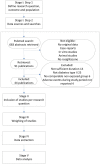Evidence Synthesis in Harm Assessment of Medicines Using the Example of Rosiglitazone and Myocardial Infarction
- PMID: 29520360
- PMCID: PMC5827152
- DOI: 10.3389/fmed.2017.00228
Evidence Synthesis in Harm Assessment of Medicines Using the Example of Rosiglitazone and Myocardial Infarction
Abstract
The current system of harm assessment of medicines has been criticized for relying on intuitive expert judgment. There is a call for more quantitative approaches and transparency in decision-making. Illustrated with the case of cardiovascular safety concerns for rosiglitazone, we aimed to explore a structured procedure for the collection, quality assessment, and statistical modeling of safety data from observational and randomized studies. We distinguished five stages in the synthesis process. In Stage I, the general research question, population and outcome, and general inclusion and exclusion criteria are defined and a systematic search is performed. Stage II focusses on the identification of sub-questions examined in the included studies and the classification of the studies into the different categories of sub-questions. In Stage III, the quality of the identified studies is assessed. Coding and data extraction are performed in Stage IV. Finally, meta-analyses on the study results per sub-question are performed in Stage V. A Pubmed search identified 30 randomized and 14 observational studies meeting our search criteria. From these studies, we identified 4 higher level sub-questions and 4 lower level sub-questions. We were able to categorize 29 individual treatment comparisons into one or more of the sub-question categories, and selected study duration as an important covariate. We extracted covariate, outcome, and sample size information at the treatment arm level of the studies. We extracted absolute numbers of myocardial infarctions from the randomized study, and adjusted risk estimates with 95% confidence intervals from the observational studies. Overall, few events were observed in the randomized studies that were frequently of relatively short duration. The large observational studies provided more information since these were often of longer duration. A Bayesian random effects meta-analysis on these data showed no significant increase in risk of rosiglitazone for any of the sub-questions. The proposed procedure can be of additional value for drug safety assessment because it provides a stepwise approach that guides the decision-making in increasing process transparency. The procedure allows for the inclusion of results from both randomized an observational studies, which is especially relevant for this type of research.
Keywords: Bayesian inference; benefit vs. risk; evidence synthesis; informative priors; safety.
Figures
Similar articles
-
Association between pacifier use and breast-feeding, sudden infant death syndrome, infection and dental malocclusion.JBI Libr Syst Rev. 2005;3(6):1-33. doi: 10.11124/01938924-200503060-00001. JBI Libr Syst Rev. 2005. PMID: 27819973
-
Procedures and methods of benefit assessments for medicines in Germany.Eur J Health Econ. 2008 Nov;9 Suppl 1:5-29. doi: 10.1007/s10198-008-0122-5. Eur J Health Econ. 2008. PMID: 18987905
-
[Procedures and methods of benefit assessments for medicines in Germany].Dtsch Med Wochenschr. 2008 Dec;133 Suppl 7:S225-46. doi: 10.1055/s-0028-1100954. Epub 2008 Nov 25. Dtsch Med Wochenschr. 2008. PMID: 19034813 German.
-
Number needed to harm in the post-marketing safety evaluation: results for rosiglitazone and pioglitazone.Pharmacoepidemiol Drug Saf. 2015 Dec;24(12):1259-70. doi: 10.1002/pds.3874. Epub 2015 Sep 16. Pharmacoepidemiol Drug Saf. 2015. PMID: 26376779
-
Rosiglitazone, myocardial ischemic risk, and recent regulatory actions.Ann Pharmacother. 2012 Feb;46(2):282-9. doi: 10.1345/aph.1Q400. Epub 2012 Jan 31. Ann Pharmacother. 2012. PMID: 22298606 Review.
Cited by
-
Rosiglitazone alleviates myocardial apoptosis in rats with acute myocardial infarction via inhibiting TLR4/NF-κB signaling pathway.Exp Ther Med. 2020 Apr;19(4):2491-2496. doi: 10.3892/etm.2020.8479. Epub 2020 Jan 30. Exp Ther Med. 2020. Retraction in: Exp Ther Med. 2021 Sep;22(3):911. doi: 10.3892/etm.2021.10343. PMID: 32256726 Free PMC article. Retracted.
References
-
- O’Neill RT. Biostatistical considerations in pharmacovigilance and pharmacoepidemiology: linking quantitative risk assessment in pre-market licensure application safety data, post-market alert reports and formal epidemiological studies. Stat Med (1998) 17(15–16):1851–8; discussion 1859–62.10.1002/(SICI)1097-0258(19980815/30)17:15/16<1851::AID-SIM987>3.0.CO;2-Z - DOI - PubMed
LinkOut - more resources
Full Text Sources
Other Literature Sources
Miscellaneous



